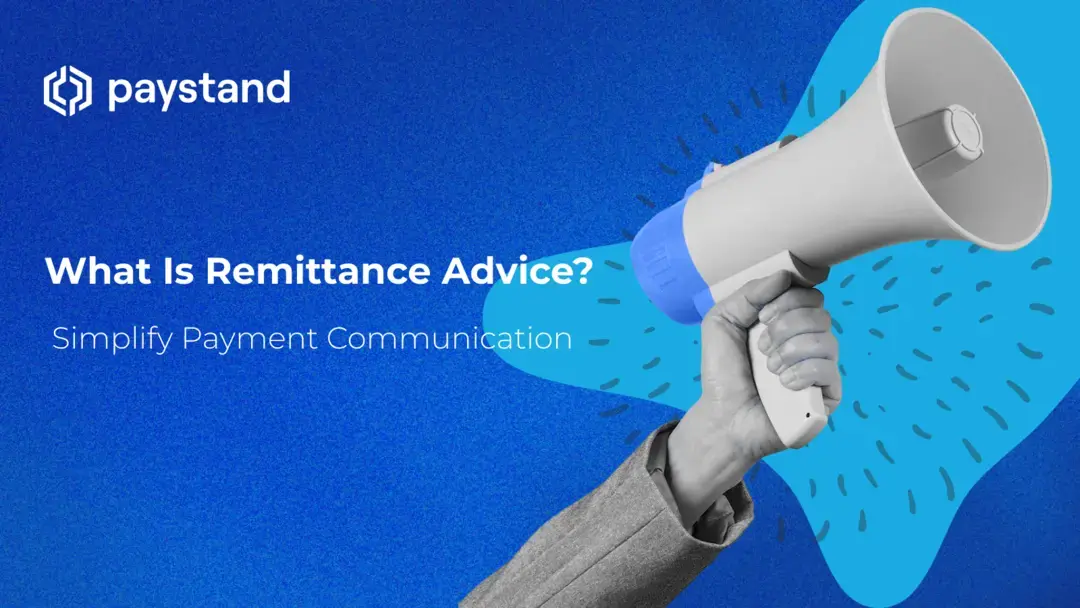What Is Remittance Advice? Simplify Payment Communication

Table of Contents
- What is remittance?
- What is remittance advice in accounting?
- What’s the best way to send remittance advice?
- What is electronic remittance advice?
- What should a remittance advice slip include?
- Do you need to send remittance advice?
- Is remittance advice proof of payment?
- Streamline payments and strengthen financial operations with Paystand
Key Takeaways
- Remittance simplifies financial transactions by ensuring payments are correctly attributed, reducing disputes, and improving record-keeping.
- Remittance advice clarifies payments and confirms which invoices or accounts they apply to, but it is not legally required.
- Sending them enhances professionalism, promotes transparency, and reduces reconciliation errors in business finance.
- While they improve communication, they’re not legal proof of payment; a bank statement or transaction record serves this purpose.
Every financial transaction tells a story. Clear communication is the foundation of effective accounts receivable management. Yet, the bridge between issuing an invoice and receiving payment is often ambiguous—enter remittance. Understanding this concept can help businesses maintain accurate financial records, strengthen vendor relationships, and avoid payment disputes.
This article unravels remittance nuances, explores types, and clarifies its role in modern finance. Whether managing payment cycles or streamlining accounting, this guide provides actionable insights. Read on to keep accounts balanced, communication clear, and payment tracking seamless.
What is Remittance?
At its core, remittance refers to transferring money from one party to another. It is commonly associated with business transaction payments for goods or services. Still, it also plays a broader role in financial processes involving international transfers, personal payments, and business settlements. In accounting and finance, remittance typically involves sending payment to a supplier or creditor and may include additional documentation for clarity, such as a remittance advice slip.
In business, remittance ensures that payments are attributed to the correct invoices, reducing confusion and fostering smooth buyer-seller relationships. Without effective remittance, companies risk delayed payment reconciliation, which leads to unnecessary follow-ups or disputes.
Difference Between Invoice and Remittance
| Invoice | Remittance Advice |
|---|---|
| Issued by the seller | Issued by the buyer |
| Requests payment for goods or services | Confirms that payment has been made |
| Includes details such as the amount due, due date, and a breakdown of items provided | Specifies how and when the funds were transferred |
| Initiates the payment process | Closes the payment process by providing a record of completed payment |
What is Remittance Advice in Accounting?
Remittance advice is a document that accompanies or follows a payment, informing the recipient that a payment has been made and specifying which invoices or accounts it applies to. It is a courteous and practical way to clarify financial transactions. While remittance advice is not always required, it supports clearer record-keeping. It helps suppliers and vendors match payments to outstanding invoices, thereby avoiding unnecessary communication about what may appear as missing payments.
Sending remittance advice shows professionalism and financial organization. It highlights attention to detail and a proactive approach to minimizing misunderstandings. In automated accounting systems, it is crucial, as it can be automatically generated to streamline payment processing.
What’s the Best Way to Send Remittance Advice?
The method you choose to send remittance advice should align with your business’s size, complexity, and technology capabilities. Email is one of the most common and cost-effective methods, offering speed and traceability. Businesses using accounting software can automate email notifications for added convenience.
Large corporations prefer electronic data interchange (EDI) for seamless system data transfers without manual input. Due to the rise of digital adoption tools, paper remittance advice has become less common. Regardless of the method, ensuring clarity, accuracy, and prompt delivery is essential for maximizing its benefits.
What is Electronic Remittance Advice?
Electronic remittance advice (ERA) is a modern digital version of this traditional document. By eliminating paper and manual processes, ERAs improve efficiency, reduce errors, and integrate seamlessly with ERP or accounting platforms. Businesses that prioritize automation in their financial workflows often rely on ERAs to streamline operations and reduce costs.
Healthcare providers use ERAs for insurance claims, while companies with recurring payments prefer them for faster processing. Electronic invoicing and payment systems have made ERAs more accessible to smaller businesses.
What Should a Remittance Advice Slip Include?
A remittance advice slip is effective only when it contains all the details for clear identification. Typically, it includes:
- The name and contact information of the payer.
- The recipient’s details (such as a supplier or vendor).
- The date of payment.
- The payment amount.
- Invoice or reference numbers associated with the payment.
- The payment method (e.g., bank transfer, credit card, or check).
This information allows the recipient to apply payment to the correct account or invoice, ensuring smooth financial reconciliation.
Missing critical details may cause confusion and errors in payment application, affecting vendor relationships and business operations.
Do You Need to Send Remittance Advice?
Remittance advice isn't legally required, but it is a best practice in business finance. It helps avoid disputes, enhances communication, and promotes transparency in financial dealings and operations. It also prevents miscommunication and streamlines bookkeeping for businesses with high payment volumes or multiple vendors. Investing time in it can yield significant returns in efficiency and relationship management.
Is Remittance Advice Proof of Payment?
One common misconception is that remittance advice serves as legal proof of payment. It does not. While it confirms that a payment was intended or issued, the actual bank statement or transaction record from a financial institution remains the definitive proof. It serves as a helpful notification or supplement to these records, providing additional context and documentation but lacking the binding authority of a formal transaction receipt.
Streamline Payments and Strengthen Financial Operations with Paystand
With the right tools, navigating the complexities of remittance and invoice management is easier. Paystand’s innovative payment platform simplifies accounts receivable management, eliminating manual processes and enabling real-time payment tracking. By automating payment reminders, remittance advice, and invoice reconciliation, businesses can reduce errors, improve cash flow, and foster better relationships with vendors.
Ready to bring efficiency and clarity to your financial operations? Discover how Paystand’s solutions can transform your payment processes. Book a demo today and see the future of finance in action






